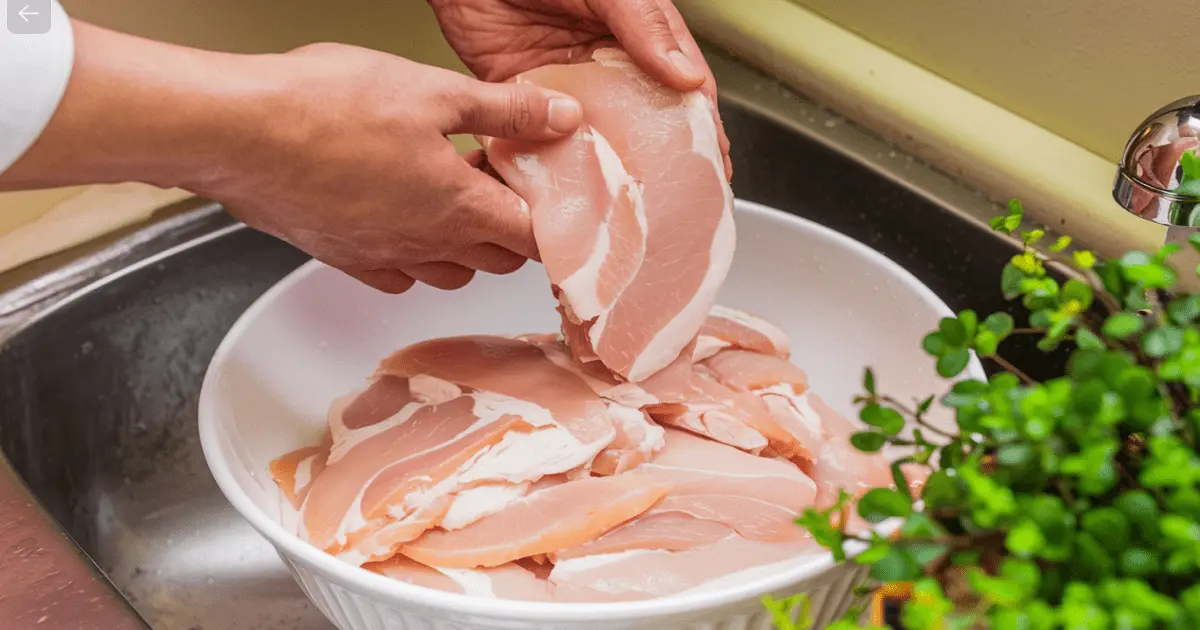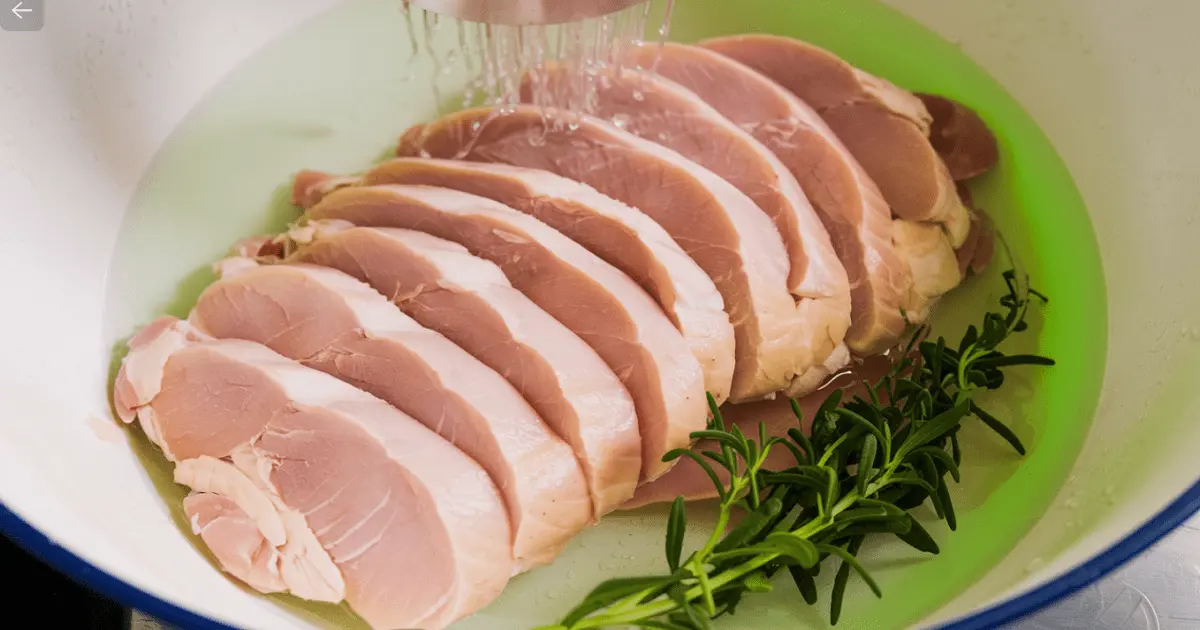When preparing chicken, especially thinly sliced chicken breasts, food safety is paramount. These cuts are favored for their versatility and lean protein content, making them a staple in countless kitchens. However, one question often comes up: Should you wash thin sliced chicken breast before cooking? This guide explores that question in depth, offering expert tips on the safest and most effective ways to handle and cook your chicken. By following these recommendations, you’ll be equipped with the knowledge to keep your chicken breasts safe from contamination while ensuring they remain juicy and flavorful in every dish.
Understanding Food Safety with Poultry
Chicken is a popular and nutritious option in many households, but it is also a common source of foodborne illnesses if not handled correctly. Raw chicken can harbor harmful bacteria such as Salmonella and Campylobacter, which can cause severe foodborne illnesses if proper precautions are not taken during preparation and cooking.
One of the most debated topics in food safety is whether you should wash chicken before cooking. The USDA strongly advises against washing raw chicken, as doing so can inadvertently spread bacteria throughout your kitchen. Water splashes during washing can carry bacteria to your sink, countertops, and other kitchen surfaces, leading to cross-contamination. This spread of bacteria increases the risk of foodborne illness.
The safest and most effective way to ensure that your chicken is free from harmful bacteria is by cooking it thoroughly. Heating chicken to the correct internal temperature, which is 165°F (74°C), effectively kills any bacteria present on the meat, making it safe for consumption.
For more information on why washing chicken is not recommended, check out The Science of Not Washing Chicken.
Why You Should Not Wash Thin Sliced Chicken Breast
Despite the widespread belief that washing chicken makes it cleaner, it actually does more harm than good. Washing chicken can spread harmful bacteria through water droplets that may travel as far as three feet from your sink. These droplets can land on kitchen surfaces, utensils, and even other foods, increasing the risk of cross-contamination and foodborne illness.
Reasons not to wash chicken include:
- Bacterial spread: Washing chicken spreads bacteria to other surfaces in your kitchen, leading to potential contamination.
- No added safety: Washing chicken does not effectively remove bacteria. Proper cooking at the correct temperature is the only way to ensure safety.
- Increased risk: The more surfaces and objects that come into contact with raw chicken, the higher the risk of spreading harmful bacteria.
The most effective way to handle chicken safely is to avoid washing it and instead focus on proper cooking methods. Cooking thin sliced chicken breasts to an internal temperature of 165°F (74°C) guarantees that all harmful bacteria are eliminated, making the chicken safe to eat.
For more guidance on chicken preparation, refer to How to Keep Thin Chicken Breast Moist.

Safe Handling Practices for Chicken Breasts
Proper handling of raw chicken breasts is essential to avoid cross-contamination in the kitchen. While washing chicken is not advisable, there are several other practices you can follow to ensure safety.
Safe handling tips include:
- Wash your hands: Always wash your hands with soap and warm water for at least 20 seconds before and after handling raw chicken. This step is essential for stopping the spread of bacteria.
- Use separate cutting boards: Designate one cutting board specifically for raw chicken to avoid contaminating other foods.
- Clean surfaces thoroughly: After preparing chicken, clean all surfaces, including countertops and utensils, with hot, soapy water to remove any bacteria.
- Proper storage: Store raw chicken in the refrigerator at or below 40°F (4°C) and cook it within 1-2 days. If you do not plan to cook the chicken within this time frame, freeze it to prevent spoilage.
By following these safe handling practices, you minimize the risk of spreading bacteria and keep your kitchen environment safe.
Cooking Techniques to Ensure Moist and Safe Chicken
Cooking chicken correctly is vital to ensure that it is both safe to eat and deliciously moist. Thinly sliced chicken breasts can dry out easily if overcooked, so you need to pay careful attention.
Tips for cooking thin sliced chicken breast include:
- Use a meat thermometer: The best way to ensure that you cook chicken safely is to check with a meat thermometer that the internal temperature has reached 165°F (74°C). This step ensures that the chicken is safe to eat while also preventing overcooking.
- Avoid overcooking: Thin slices of chicken cook quickly. Keep a close watch to avoid overcooking, which can result in dry, tough meat.
- Moist cooking methods: Techniques like baking in foil, poaching, or slow cooking can help retain moisture in the chicken, resulting in a tender, juicy texture.
These cooking techniques will help you achieve perfectly cooked chicken that is both safe and enjoyable to eat.
For more detailed advice on cooking thin chicken breasts without drying them out, check out How to Cook Thin Chicken Breasts Without Overcooking.
Prepping Chicken Without Washing
While washing chicken is not necessary or recommended, proper preparation before cooking is still essential. This includes trimming, seasoning, and sometimes tenderizing the chicken to ensure it cooks evenly and tastes great.

Steps for prepping chicken for cooking:
- Trimming: Remove any excess fat or tendons from the chicken breasts. Trimming not only improves the appearance but also ensures an even texture throughout the cooked chicken.
- Seasoning: Season the chicken with salt, pepper, and any other preferred herbs or spices. Seasoning enhances the flavor of the chicken and adds depth to the overall dish.
- Tenderizing: If the chicken breasts have uneven thickness, consider pounding them to achieve uniform thickness. This ensures even cooking and prevents parts of the chicken from drying out.
By following these preparation steps, your chicken will be ready for cooking and will deliver the best possible flavor and texture.
Cooking Thin Sliced Chicken Breast in a Crockpot
The crockpot or slow cooker is a great tool for cooking thin sliced chicken breasts, as it allows the meat to cook slowly and evenly, retaining moisture and flavor.
Cooking thin sliced chicken breast in a crockpot:
- Cooking time: In a crockpot, thin sliced chicken breasts typically require about 2-3 hours on low or 1-2 hours on high. However, always check the internal temperature to ensure it has reached 165°F (74°C) before serving.
- Moisture retention: To keep the chicken moist, add a small amount of broth or water to the crockpot. Keeping the lid on during cooking helps to trap steam and moisture, resulting in tender, juicy chicken.
- Flavor enhancement: You can add vegetables, herbs, and spices to the crockpot along with the chicken. These ingredients will infuse the chicken with additional flavors during the slow cooking process.
Using a crockpot is a convenient method for cooking chicken, especially when you need a hands-off approach.
For more on slow cooking chicken, you might find How to Cook Thin Sliced Chicken Breast in Crockpot helpful.
How to Know When Thin Sliced Chicken Breast Is Done
Ensuring that thin sliced chicken breast is fully cooked is essential for both safety and texture. Undercooked chicken poses a health risk, while overcooked chicken can become dry and unappetizing.
Key indicators that chicken breast is done:
- Internal temperature: The most reliable way to know when chicken breast is done is by using a meat thermometer. The chicken becomes safe to consume once it reaches an internal temperature of 165°F (74°C).
- Clear juices: When cutting into the chicken, the juices should run clear, not pink. Pink juices indicate that the chicken is not fully cooked.
- Firm texture: Cooked chicken should feel firm to the touch, but not overly hard. If the chicken is still soft or mushy, it needs more time to cook.
- Visual cues: The chicken should be opaque and white throughout, with no pink or translucent areas remaining.
By monitoring these signs, you ensure that your chicken breast is fully cooked, safe to eat, and has the right texture.
FAQs: Should you wash thin sliced chicken breast?

How to clean thin chicken breast?
You do not need to wash chicken breasts to clean them. Instead, focus on trimming any excess fat or tendons and ensure proper handling and preparation. This approach prepares your chicken for cooking without the need for washing, reducing the risk of spreading bacteria.
Is it necessary to wash chicken breasts before cooking?
No, it is not necessary to wash chicken breasts before cooking. Washing can spread bacteria to other kitchen surfaces, increasing the risk of cross-contamination. Cooking chicken to an internal temperature of 165°F (74°C) is the best way to ensure it is safe to eat.
How long does it take to cook thin sliced chicken breast in the crockpot?
In a crockpot, thin sliced chicken breasts typically take about 2-3 hours on low or 1-2 hours on high. However, using a meat thermometer confirms that the internal temperature reaches 165°F (74°C), ensuring the chicken is fully cooked and safe to eat.
How do you know when thin sliced chicken breast is done?
The best way to determine if thinly sliced chicken breast is done is by checking the internal temperature with a meat thermometer. You consider the chicken fully cooked when it reaches an internal temperature of 165°F (74°C). Additionally, the juices should run clear, and the meat should feel firm and opaque..
Final Thoughts on Handling Thin Sliced Chicken Breast
Proper handling and cooking of thin sliced chicken breast is crucial for ensuring both safety and flavor. Many people mistakenly believe that washing chicken before cooking makes it safer, but this practice actually increases the risk of spreading harmful bacteria around your kitchen. Instead of washing, it’s far more effective to focus on the right preparation and cooking techniques. By doing so, you can achieve a meal that is not only delicious but also safe to eat.
This article provides comprehensive guidelines to help you enjoy juicy, tender chicken breasts every time, without the worry of foodborne illnesses. These tips help you make the most out of your chicken dishes, covering everything from proper storage to the best cooking methods. Whether you’re slow-cooking in a crockpot or quickly searing on the stovetop, the key to great chicken lies in how you prepare and cook it. Prioritize safety and flavor, and you will achieve consistently excellent results.
For more tips on cooking chicken breasts perfectly, you can explore Proper Cooking Techniques for Chicken and Understanding Cross-Contamination in the Kitchen.

